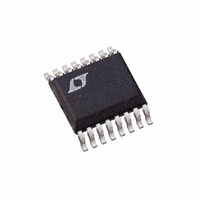LT1768CGN Linear Technology, LT1768CGN Datasheet - Page 10

LT1768CGN
Manufacturer Part Number
LT1768CGN
Description
IC CTRLR CCFL SGL/MULT HP 16SSOP
Manufacturer
Linear Technology
Type
CCFL Controllerr
Datasheet
1.LT1768CGN.pdf
(20 pages)
Specifications of LT1768CGN
Frequency
300 ~ 410 kHz
Current - Supply
7mA
Current - Output
1.5A
Voltage - Supply
9 V ~ 24 V
Operating Temperature
0°C ~ 125°C
Package / Case
16-SSOP
Lead Free Status / RoHS Status
Contains lead / RoHS non-compliant
Available stocks
Company
Part Number
Manufacturer
Quantity
Price
Company:
Part Number:
LT1768CGN
Manufacturer:
LT
Quantity:
10 000
Part Number:
LT1768CGN
Manufacturer:
LINEAR/凌特
Quantity:
20 000
Part Number:
LT1768CGN#PBF
Manufacturer:
LINEAR/凌特
Quantity:
20 000
Part Number:
LT1768CGN#TRPBF
Manufacturer:
LINEAR/凌特
Quantity:
20 000
LT1768
The current mode pulse width modulation produces an
average current in inductor L1 proportional to the VC
voltage. Inductor L1 then acts as a switched mode current
source for a current driven Royer class converter with
efficiencies as high as 90%. T1, C4 and Q1 comprise the
Royer class converter which provides the CCFLs with a
zero DC, 60kHz sinusoidal waveform whose amplitude is
based on the average current in L1. Sinusoidal current
from both CCFLs is then returned to the LT1768 through
the DIO1/2 pins. A fraction of the CCFL current from the
negative half of its sine wave pulls against the internal
current source at the VC pin closing the loop. A single
capacitor on the VC pin provides loop compensation and
CCFL current averaging, which results in constant CCFL
current. Varying the value of the internal current source via
the Multimode Dimming block varies the CCFL current and
resultant CCFL light intensity.
Multimode Dimming
Previous backlighting solutions have used a traditional
error amplifier in the control loop to regulate lamp current.
The approach converted AC current into a DC voltage for
the input of the error amplifier. This approach used several
time constants in order to provide stable loop compensa-
tion. This compensation scheme meant that the loop had
to be fairly slow and that the output overshoot with start-
up or load conditions had to be carefully evaluated in terms
of transformer stress and breakdown voltage require-
ments. In addition, intensity control schemes were limited
to linear or PWM control. Linear intensity control schemes
provide the highest efficiency backlight circuits but either
limit dimming range, or violate lamp minimum or maxi-
mum CCFL current specifications to achieve wide dim-
ming ratios. PWM control schemes offer wide dimming
range but produce waveforms that may degrade CCFL life,
and waste power at higher CCFL currents. The LT1768’s
Multimode Dimming eliminates the error amplifier con-
cept entirely and combines the best of both control schemes
to extend CCFL life while providing the widest possible
dimming range.
The error amplifier is eliminated by summing the current
out of the Multimode Dimming block with a fraction of
feedback lamp current to form the control loop. This
topology reduces the number of time constants in the
10
APPLICATIONS
U
INFORMATION
U
W
U
control loop by combining the error signal conversion
scheme and frequency compensation into a single capaci-
tor (VC pin). The control loop thus exhibits the response
of a single pole system, allows for faster loop transient
response and minimizes overshoot under start-up or
overload conditions.
Referring to Figure 2, the source current into the VC pin
from the Multimode Dimming block (and resultant CCFL
current) has five distinct modes of operation. Which mode
is in use is determined by the voltages on the PROG and
PWM pins, and the currents that flow out of the R
R
Off Mode (V
zero, actively pulls VC to ground, and inhibits the GATE pin
from switching which results in zero lamp current.
Minimum current mode (0.5V < V
source current equal to the current out of the 1.26V
referenced R
determines the dimming range of the display. Setting
R
CCFL current guarantees the maximum CCFL lifetime for
all PROG voltages, but limits the dimming range. Setting
R
minimum specified CCFL current increases dimming range,
but places restrictions on the PROG voltage for normal
operation in order to maximize lifetime. To achieve the
maximum dimming ratio possible, I
zero by connecting the R
For example, the circuit in Figure 1 produces a dimming
ratio of 100:1 at 1mA of lamp current, but sets the
minimum CCFL current to zero (R
V
1.12V to limit the CCFL current to 1mA (1mA is only a
typical minimum lamp current used for illustration, con-
sult lamp specifications for actual minimum allowable
value) during normal operation in order to meet CCFL
specifications to maximize lifetime. It should be noted that
taking the PROG voltage in Figure 1 down to 1V (0mA
CCFL current) enables dimming ratios greater than 500:1,
but violates minimum CCFL current specifications in most
lamps and is not recommended. Alternatively, discon-
necting R
R
REF
MIN
RMIN
RMIN
MIN
). In this case, the PROG voltage must be kept above
to AGND in Figure 1 sets the minimum CCFL current
pins.
to produce the manufacturer’s minimum specified
to produce currents less than the manufacturer’s
MIN
PROG
MIN
from V
pin. The minimum VC source current
< 0.5V), sets the VC source current to
REF
and adding a 10k resistor from
MIN
pin to the V
PROG
RMIN
MIN
< 1V) sets the VC
is connected to
should be set to
REF
pin.
MAX
and














